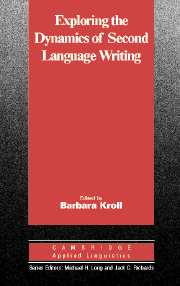Book contents
- Frontmatter
- Contents
- List of contributors
- Acknowledgments
- List of abbreviations used
- Series editors' preface
- Introduction: Teaching the next generation of second language writers
- I EXPLORING THE FIELD OF SECOND LANGUAGE WRITING
- II EXPLORING THE VOICES OF KEY STAKEHOLDERS:TEACHERS AND STUDENTS
- III EXPLORING WRITERS' FINISHED TEXTS
- IV EXPLORING CONTEXTUALITIES OF TEXTS
- V EXPLORING TECHNOLOGY
- EPILOGUE: EXPLORING OURSELVES
- Index
V - EXPLORING TECHNOLOGY
Published online by Cambridge University Press: 05 October 2012
- Frontmatter
- Contents
- List of contributors
- Acknowledgments
- List of abbreviations used
- Series editors' preface
- Introduction: Teaching the next generation of second language writers
- I EXPLORING THE FIELD OF SECOND LANGUAGE WRITING
- II EXPLORING THE VOICES OF KEY STAKEHOLDERS:TEACHERS AND STUDENTS
- III EXPLORING WRITERS' FINISHED TEXTS
- IV EXPLORING CONTEXTUALITIES OF TEXTS
- V EXPLORING TECHNOLOGY
- EPILOGUE: EXPLORING OURSELVES
- Index
Summary
There can be little doubt that computers have vastly altered how writers produce texts. From the obvious use of computer keyboards as alternatives to the typewriters that earlier replaced pen and paper as the most typical means of transcribing ideas into words, to the ease with which electronic mail facilitates communication across near and vast distances, technological advances continue to shape people's literate activities (see Kern, 2000, pp. 223–266).
The contributions of technology to the field of language learning go back a long way and extend well beyond the role of computers in writing courses (for brief overviews of numerous possibilities, see Hanson-Smith, 2001; Sokolik, 2001). Still, it is critical for writing teachers to remember that they have a vital role to play in helping their students find (new) ways to use computers effectively for writing and research purposes. For example, information available via the World Wide Web has altered and expanded the ways in which student researchers can access data and ideas (Slaouti, 2002), offering a path to greater control over their own learning.
For some teachers and students, creating an expanding role for computers will involve overcoming computer anxiety; this leads to a kind of resistance that can prove counter-productive to achieving improvement in academic writing skills (cf. Davidson & Tomic, 1994). In an online review of Jane Ward Schofield's book Computers and Classroom Culture (Cambridge University Press, 1995), Bump (2000) notes that “teacher resistance remains the primary obstacle to the advance of [computer use] in English,” echoing Schofield's finding that many teachers enrolled in university courses reported fear, anxiety, and phobia in regard to computer use.
- Type
- Chapter
- Information
- Exploring the Dynamics of Second Language Writing , pp. 285 - 286Publisher: Cambridge University PressPrint publication year: 2003

